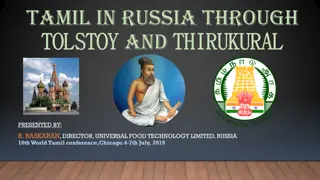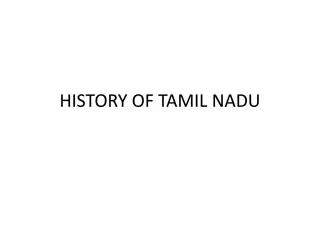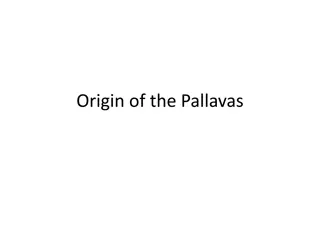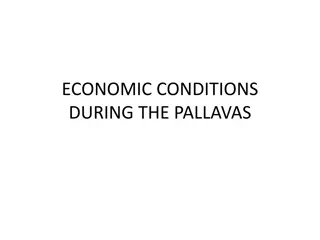Administration of the Pallavas: Organized Governance in Ancient Tamil Country
The Pallava kings established a well-organized administration in the Tamil Country, mirroring the Mauryan system. Administrative units like Mandalam, Kottam, Nadu, and Ur were pivotal in governing the vast Pallava Empire. The monarchy was led by the king, who claimed divine origin, with efficient Council of Ministers supporting the governance structure.
Download Presentation

Please find below an Image/Link to download the presentation.
The content on the website is provided AS IS for your information and personal use only. It may not be sold, licensed, or shared on other websites without obtaining consent from the author.If you encounter any issues during the download, it is possible that the publisher has removed the file from their server.
You are allowed to download the files provided on this website for personal or commercial use, subject to the condition that they are used lawfully. All files are the property of their respective owners.
The content on the website is provided AS IS for your information and personal use only. It may not be sold, licensed, or shared on other websites without obtaining consent from the author.
E N D
Presentation Transcript
ADMINISTRATION OF THE PALLAVAS
INTRODUCTION The Pallava kings had a well organised administration and introduced sevsral administrative institutions in the Tamil Country and they had adopted the Mauryan system of Administration . Administrative Divisions The Pallavas had a vast empire , extended up to the Nellore district in the North and upto the river South Pennar in the South . On the west , it had extended up to the Western Ghats and on the East up to the Bay of Bengal . It was very difficult to have administrative control . The Pallavas had divided the empire into several administrative units called as Mandalam , Kottam , Nadu and Ur .
These administrative divisions may be compared with the modern administrative units , namely Province , District , Taluk and Village Mandalam The biggest unit of the Pallava Empire was Mandalam or Rashtra , remained almost an autonomous unit . The Pallava king had appointed a prince or Yuvaraja as the governor of a Mandalam , direct control over the Mandalam . Kottam Each Mandalam was divided into several Kottams. The number of Kottems varied according to the size of the Mandalam . The Thondai Mandalam was divided into twenty four Kottams Officials were appointed by the king to administer each Kottams
Nadu The next administrative unit was called Nadu . Nadu was bigger than Oor or village , several villages in each Nadu A council called Nattar was in charge of the administration of Nadu Oor The Oor or Village was the smallest unit of the Pallava administration , under the control of the Village Committees called Sabhas , it was an autonomous body looking after the Day to Day administration of the village . The members of Oor Sabha were known as Perumakkal . Each Sabha was divided into separate Committees called Variyams . Each Variyam had looked after the administration of temple , Irrigation Tanks and Village Gardens . It can be said that the Pallavas had laid the foundation for the future expansion of Village administration during the Later Cholas
Central Government Monarchy The Pallavas had followed the system of monarchy , the king was the head of the kingdom . Hereditary succession to the throne had been in practice , the eldest son would be the next ruler . The Pallava kings had considered themselves as the representative of God . They had assumed many titles like Maharaja , Maharajathi Raja , and Dharma Rajathiraja . These titles indicate the imperial power of the Pallava kings , had also claimed a Divine Origin .
Council of Ministers . There was an efficient Council of Ministers in the Pallava Kingdom . The Ministers were known as Amatyas . The Minister carried out the orders of the king and rendered their co-operation and service to the king in all matters of administration . The king appointed other officials to each department to look after the administration of that department . Judiciary . There were three types of Courts in the Pallava kingdom , the King acted as its head . The Highest judicial organization was called Dharmasena . The Courts in the towns were known as Adikarnas The Village courts were called as Karnas , it look after the civil disputes in the Villages .
Army The Pallavas had a strong and big army There were four divisions in the Army , Infantry , Cavalry , Elephants and Chariots . The Cavalry played a vital role in the wars The Pallvas also had a Navy . Revenue . Land tax was the main source of income to the government . The copper plates and Inscriptions of the Pallavas mentioned Eighteen kinds of Taxes were collected by the Pallavas . The number of Lakes , Tanks , Wells , Rivers and Trees were counted for the purposes of taxation . Taxes were also levied on Oil - Pressers , Washermen , Goldsmith and Cattle breeders .
Taxes were known by different names such as Kaanam , Irai , Pattam , and Puchi For example , the term Kusakaanam refers to the tax on Potters and Thari Irai to the tax on weavers . ______























